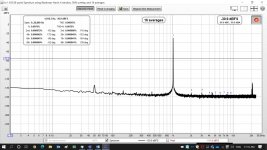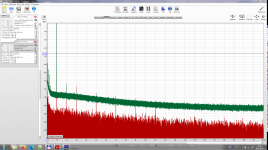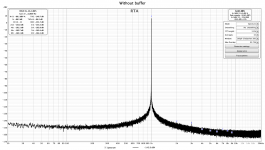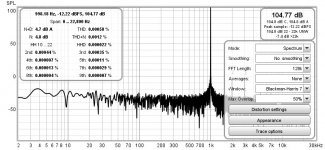When making a cable from victors oscillator to my Motu M2 via phono to xlr, which pins do I connect? Is it signal to pin 2 ground to 1 and 3 or something else?
I've seen that but I'm getting terrible results and wanted to see if I'd connected it wrong, so again to connect the phono output from the oscillator the signal (+) goes to pin 2 that much I know is correct, signal ground goes to pin 1 yes but do I then connect pins 1 and 3 together as the input to the xlr is single ended.
reddish75 here is my M2 with RickRay's suggested pin out. This is using Akitika's 2ppm osc. The grass around 20khz seems to be coming from the laptop. The M2 is so sensitive even moving the laptop away by about foot makes a difference to the noise floor. As does disconnecting all other usb devices.
Attachments
I should add... Id be keen to see your results when you get it sorted. Im sure this unit will go sub ppm with the right osc.
Triplej, you may be able to lower the noise floor by using a larger FFT.
I doubt there is a way, but it would be very neat to if REW's coherent averaging could somehow be implemented with an external oscillator - perhaps by syncing the external oscillator to an REW generated oscillator signal of the same frequency.
2ppm doesn't seem that low compared to Victor's which I recall is circa 0.01ppm (if that is ~-150dBr). Can't the M2 generate its own signal that is down near the noise floor, as that could then use coherent averaging and added harmonics.
I doubt there is a way, but it would be very neat to if REW's coherent averaging could somehow be implemented with an external oscillator - perhaps by syncing the external oscillator to an REW generated oscillator signal of the same frequency.
2ppm doesn't seem that low compared to Victor's which I recall is circa 0.01ppm (if that is ~-150dBr). Can't the M2 generate its own signal that is down near the noise floor, as that could then use coherent averaging and added harmonics.
Thanks trobbins, FFT length? setting to max makes no difference its around 116 dbfs with inputs unplugged. looped back using REW's osc. i get a similar 00016%. I tried cancelling the harmonics with limited success. Yes the Akitika is limiting the measurement here hence I'm keen to see what reddish can achieve!
I usually find that for external sources, setting FFT length higher (eg. 2M or 4M) along with max averages will lower the noise floor noticeably - the downside is it takes a longer time to make every measurement and then average, so plot updates can take a long time (perhaps depending on the PC grunt).
If you do a loopback then you can turn on coherent averaging, and lower FFT length to circa 64k, and max the averages to get an even lower noise floor. That typically allows the harmonics to be more discernible, which can help when trying to null harmonics by adding REW harmonics. Also it can take a while to work out a technique to lower each harmonic - which I find requires first iterating magnitude to where it just has an effect, and then adjusting phase (+ or -) to get a minimum, then going back to iterate magnitude by 1 or 2 dB to try and detect a minima, and then iterating phase by a few degrees either side to find a minima, and iterating again to confirm you can or can't get a better null. Those iterations are best done with a low averaging number otherwise it can take ages to get each refresh.
PS. I just looked at your plot again - the THD reported level appears to be including unrelated signals - which can avoided by using suitable low and high filter frequencies in the Distortion settings control box.
If you do a loopback then you can turn on coherent averaging, and lower FFT length to circa 64k, and max the averages to get an even lower noise floor. That typically allows the harmonics to be more discernible, which can help when trying to null harmonics by adding REW harmonics. Also it can take a while to work out a technique to lower each harmonic - which I find requires first iterating magnitude to where it just has an effect, and then adjusting phase (+ or -) to get a minimum, then going back to iterate magnitude by 1 or 2 dB to try and detect a minima, and then iterating phase by a few degrees either side to find a minima, and iterating again to confirm you can or can't get a better null. Those iterations are best done with a low averaging number otherwise it can take ages to get each refresh.
PS. I just looked at your plot again - the THD reported level appears to be including unrelated signals - which can avoided by using suitable low and high filter frequencies in the Distortion settings control box.
I think the reported THD level has led many astray to thinking their harmonic distortion performance was quite poor, when it was often very good. It's so easy for parasitic signals from a test setup to show up in a measurement and get taken for real, and in this case to skew an often reported value (given that it wasn't too long ago that only THD could be measured).
The coherent averaging in REW works perfectly fine with an external oscillator.I doubt there is a way, but it would be very neat to if REW's coherent averaging could somehow be implemented with an external oscillator - perhaps by syncing the external oscillator to an REW generated oscillator signal of the same frequency.
Impressing! Which ADC did you use?View attachment 1018946View attachment 1018947Here is a 1kHz Victor oscillator (at max output) recorded with conventional and coherent averaging, respectively.
This was done using the RTX6001 analyser, but I think several sound cards can do almost as well.
Much credit goes to the Victor oscillator, which has a distortion and noise floor well below that of the analyser.
Much credit goes to the Victor oscillator, which has a distortion and noise floor well below that of the analyser.
FWIW, here is a result obtained with a modified Motu AudioExpress sound card.
The setup was Victors's at 2.5V followed by a unity-gain 1656 buffer in the same box, feeding a notch filter whose output was amplified by a 60dB Wurcer's LNA from this forum. The FFT had a length of 512k, spectral window was Blackman-Harris 7, 100 averages.
The green spectrum refers to the standard, i.e. linear averaging, the red one to the coherent averaging.
Comparing the harmonics in the respective THD result boxes, the 2nd harmonic is practically the same at about -106dBFS, but the 3rd one is higher by 5dB when averaged coherently. The other odd harmonics are also much higher in the coherent version, but of no concern here since their true level is much lower due to the notch filter residuum having been amplified by 60dB. For example, accounting for the notch filter attenuation and the LNA gain, the 2nd harmonic lands at -156dBc (standard caution as regards possible distortion cancellation applies).
Regards,
Braca
The setup was Victors's at 2.5V followed by a unity-gain 1656 buffer in the same box, feeding a notch filter whose output was amplified by a 60dB Wurcer's LNA from this forum. The FFT had a length of 512k, spectral window was Blackman-Harris 7, 100 averages.
The green spectrum refers to the standard, i.e. linear averaging, the red one to the coherent averaging.
Comparing the harmonics in the respective THD result boxes, the 2nd harmonic is practically the same at about -106dBFS, but the 3rd one is higher by 5dB when averaged coherently. The other odd harmonics are also much higher in the coherent version, but of no concern here since their true level is much lower due to the notch filter residuum having been amplified by 60dB. For example, accounting for the notch filter attenuation and the LNA gain, the 2nd harmonic lands at -156dBc (standard caution as regards possible distortion cancellation applies).
Regards,
Braca
Attachments
NicMac, afaik Victor has steadily improved his oscillator over the years - the most credible measurement I've seen is in this link ( https://www.audiosciencereview.com/forum/index.php?threads/e1da-cosmos-adc.27038/page-2#post-946458 ) which shows 3HD as the highest level harmonic at -150dBr. It may be that the measurements in #1173 are displaying harmonics generated in the RTX6001 and soundcard setup - if that was the case then a notch filter would be needed to suppress the RTX6001/soundcard generated harmonics (which was a recent topic I went through with my EMU0404 in https://www.diyaudio.com/community/...adc-and-dac-side-harmonic-distortions.381839/).
I looked up John's notes for coherent averaging on the REW forum - https://www.avnirvana.com/threads/coherent-averging.7001/#post-51899
So when measuring an external oscillator, REW can determine the fundamental frequency and go from there, or the fundamental frequency can be measured (eg. by REW) and REW's tone generator can be set to generate that exact frequency and that will then force REW to that fundamental frequency.
I looked up John's notes for coherent averaging on the REW forum - https://www.avnirvana.com/threads/coherent-averging.7001/#post-51899
So when measuring an external oscillator, REW can determine the fundamental frequency and go from there, or the fundamental frequency can be measured (eg. by REW) and REW's tone generator can be set to generate that exact frequency and that will then force REW to that fundamental frequency.
When using an external oscillator, like the Victor, I strongly recommend not to activate the REW tone generator. If the frequency you set in the tone generator is different from the real incoming signal the RTA harmonic calculations are nonsense. IMO this is more a bug than a feature of REW.I looked up John's notes for coherent averaging on the REW forum - https://www.avnirvana.com/threads/coherent-averging.7001/#post-51899
So when measuring an external oscillator, REW can determine the fundamental frequency and go from there, or the fundamental frequency can be measured (eg. by REW) and REW's tone generator can be set to generate that exact frequency and that will then force REW to that fundamental frequency.
There may be situations (very long recordings at narrow bin size) where you wish to use the REW tone generator to pilot you external oscillator, but I would still prefer to have harmonic calculations done solely on the recorded data, rather than on what I'm trying to pilot them to be.
- Home
- Design & Build
- Software Tools
- How to - Distortion Measurements with REW



